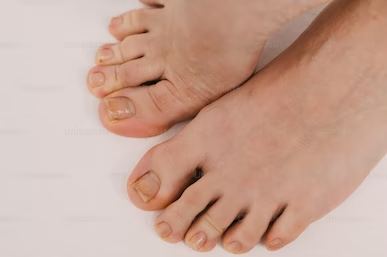Perform Regular Foot Exams
In addition to foot exams at your checkups, perform daily exams at home. Build it into your daily routine. Check for broken skin, redness, warmth, sores, calluses, excessive skin dryness, and scaling. If you see anything that concerns you, contact your doctor. If you notice tingling, burning, or numbness in your feet or legs, you should talk to your doctor about that as well. Likewise, blue skin on your feet or constantly cold feet could be a sign of poor circulation and should be reported to your physician.

Stay on Top of Your Blood Sugar
If you keep your blood sugar levels close to your target goals, then you greatly reduce your chance of nerve damage or circulation issues in your feet. That means eating right, exercising, and seeing your doctor regularly. There are a few other things you can do as well to reduce your risk of complications.
Quit smoking — If you smoke, get the help you need to quit. Smoking is bad for your circulation.
Avoid anything that can injure your feet — Walking barefoot puts you at risk of injuring your feet, so it’s best to always wear shoes. Also, avoid hot baths or a heating pad on your feet. Wear comfortable shoes with good support.
Be careful how you cut your toenails — Cut your toenails straight across and avoid getting them too short. Never cut your cuticles as this can invite infection. If you have an ingrown toenail or a callus, see a podiatrist for help. Don’t go to the nail salon.
Keep your feet clean — Wash your feet daily being sure to clean between the toes. Dry your feet well and apply lotion. Keep up with your daily foot exams. Right after your bath or shower is the perfect time to examine your feet. If you have any blisters or sores on your feet, don’t pick at them. Apply antibiotics and let them heal on their own. If they aren’t healing, see your doctor.
Choose your shoes and socks with care — Cotton socks that aren’t too tight are best. Avoid narrow-toe shoes. Be sure your shoes fit well and aren’t too tight. Switch up the shoes that you wear. Wearing the same shoe every day can put repeated pressure on your feet in the same places. If you have deformities, ask about specialized footwear to accommodate.

Foot Ulcer Treatments
If you do develop a foot ulcer, treatment will depend on how advanced it is.
Superficial ulcers — A superficial ulcer is in the top few layers of skin. They are treated by removing dead skin and thoroughly cleaning the area. This process called debridement should only be done by your doctor. Your doctor will use a scalpel or scissors to cut away the dead skin. After the ulcer is cleaned, it should be covered with a bandage to protect it. If there’s any sign of infection, you will be prescribed antibiotics. It’s important to keep the area clean and change the bandage as it heals. Keep off the foot as much as possible and prop it up when you sit. If needed, you may get a cast to keep pressure off the ulcerated area.
Deep ulcers — For ulcers that extend past the top few layers of skin into the muscle and sometimes bone, hospital treatment is necessary. Labs and x-rays may be done. Antibiotics by I.V. are usually par for the course in these cases. The area will be debrided just like with a superficial ulcer, but if the bone is affected then surgery may be required. A procedure called negative pressure wound therapy is often used. With this therapy, the ulcer is treated with a vacuum to increase circulation and speed the healing process.
If the damage to the foot is too great, partial or complete amputation could be necessary. That’s why you must follow your diabetes management plan to prevent major ulcers from developing. Foot problems are one of the main diabetes complications. They can be serious and even life-threatening, but luckily they can be prevented through proper foot care and diabetes management. If you smoke, quitting is vital. It’s one of the most important things you can do to prevent circulation and foot issues. Keeping your blood sugar in your target range will also ward off major issues with your feet.

